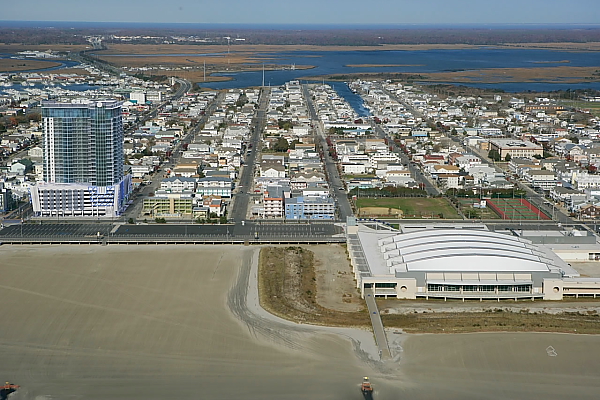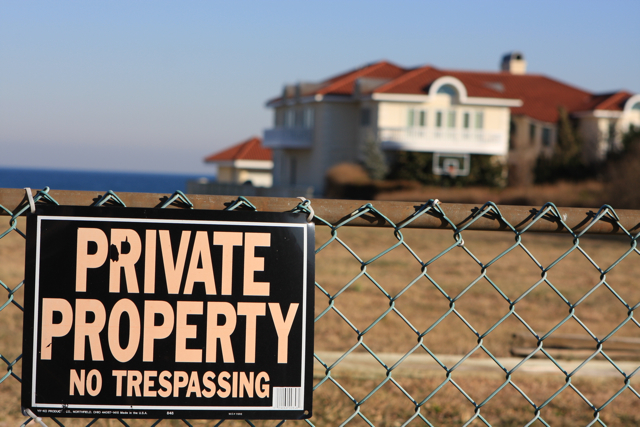
Wildwood, NJ (photo by “Greg” from “Doo Wopper” website)
It’s funny how perspective and learning randomly happens sometimes.
I was planning to write another post today on the controversial DEP public access rule proposal. (see today’s Kirk Moore story for the latest developments Beach access advocates say Shore towns can’t be trusted to craft public access plans)
I wanted to emphasize the fact that the DEP proposal – which essentially delegates State responsibility and DEP regulatory power to local land use planning – originated in the Christie DEP Transition report and the Red Tape review process.
The DEP Transition report targeted the access issue with this recommendation (@page 7):
Reexamine regulations to ensure they are properly focused on specific, well defined goals, and minimize or eliminate peripheral requirements. An example of this is the waterfront Public Access rule adopted by DEP in 2007 without direction from the Legislature, which completely changed the existing waterfront public access framework and imposed onerous new fees without standards for how the fee would be applied or calculated.
The Red Tape report went further and harshly blasted the DEP access rules as an example of regulations that “offend common sense“:
2. Examples of Rules that Appear to Offend Common Sense
N.J.A.C. 7:7 and N.J.A.C. 7:7E, respectively – Public Access RulesThe Group heard testimony at the Montclair State University meeting regarding the implementation of the Department of Environmental Protection (DEP) Public Access Rules. The regulations were adopted in December 2007 as amendments to the rules governing the administration of the Coastal Permit Program and Coastal Zone Management regulations, addressing the public’s right to the access and use of tidal waterways and their shores “ including the ocean, bays and tidal rivers in the State. Specifically, the regulations require that as a condition of receiving a permit, on-site, permanent, unobstructed public access to the tidal waterways and shores need be provided on a 24-hour, seven-day-a-week basis. If the access is not practicable, then DEP regulations require that a payment be made to DEP to provide off-site access somewhere else. The Group heard testimony from marina operators, the business community and port operators that the regulations will impact security at military installations, sensitive industrial facilities, commercial ports and harbors and energy facilities.
Understanding this history is key because this origin and original intent completely destroys current DEP spin that the intent is to “enhance” and “expand” public access, as DEP’s May 23 press release falsely claimed.
This has absolutely NOTHING to do with expanding or enhancing public access.
The obvious intent of the proposal is to deregulate and promote development and developers’ access to the shore.
[Update: here is DEP deregulatory Q&A spin: DEP has gone from prescriptive rules to local delegation:
How do these requirements differ from previous public access requirements?
The Department believes that environmental and policy goals can be accomplished without extensive and proscriptive (sic) regulatory requirements.
Purpose of This Rule ProposalThis rule seeks to maintain and enhance the public’s access to coastal and tidal waters in a reasonable, planned manner. It seeks to build on the Public Trust Doctrine, which is a piecemeal, site-specific, common law doctrine, by developing a comprehensive, yet flexible, public access plan for the entire state.
That’s a load of crap. Does Ray Cantor think we’re stupid?
I previously wrote about the Red Tape origins. In that March 2010 post, I highlighted the testimony of a Wildwood developer at the March 23, 2010 Montclair State public hearing.
According to the Bergen Record coverage of that hearing:
Richard Patterson, managing member of Martinique Resorts LLC, said the company has spent almost $2 million trying to comply with the permit process on a plan to build a high-rise hotel in Wildwood.
While state law requires 292 spaces, the Department of Environmental Protection wants 686, Patterson said, adding that the project is now in its sixth year of planning.
“More than a handful of brand-name hotel chains have walked away” because of the parking issue, he said.
So I just went back and researched some of the regulatory history of the Wildwood hotel project and the DEP CAFRA rules regarding parking.
It turns out, that the Corzine DEP already made major regulatory concessions to promote shore redevelopment by dramatically reducing parking requirements for new hotels and other commercial developments.
As Mr. Patterson or Martinique Resorts noted above and testified to the Red Tape Commission, developers hate parking requirements because they cost up to $25,000 per space and reduce the development intensity of income earning development (e.g. less square feet for profitable hotel rooms, and more for expensive parking).
DEP CAFRA parking regulations are far more stringent (i.e. require more spaces) than local parking under the Municipal Land Use Law (under formulas in the Residential Site Improvement Standards).
Parking requirements are directly related to the public access issues. Simply, off site hotel parking displaces public parking required for beach access. Here DEP’s reason for regulating parking:
N.J.A.C. 7:7E-8.14, traffic, contains the requirements for the movement of vehicles and pedestrians within the coastal zone. N.J.A.C. 7:7E-8.14(e) addresses the provision of parking to accompany coastal residential development. Adequate onsite or off-site parking for residential development ensures that on-street parking remains available for use by beachgoers, consistent with public trust rights, the Shore Protection Master Plan, and with the coastal goal regarding meaningful public access to and use of tidal waterways and their shores (see N.J.A.C. 7:7E-1.1(c)3).
I admit that I missed this DEP CAFRA rulemaking, but I don’t recall any organized opposition to it. I failed to realize how huge a giveaway it was to developers and fully understand the significant relationship of parking requirements to the public access issues.
The Corzine DEP proposed new CAFRA rules that relaxed parking requirements in January 2009. The Corzine proposal, although delayed by the Christie regulatory moratorium under Executive Order #1, was later adopted in June 2010 by the Christie DEP.
Back in March 2010, I wrote that the 2009 Corzine proposal had expired, and it actually may have. I noted that at the Red Tape March 2010 hearing, DEP Commissioner Martin was embarrassed by the fact that he was unaware of this issue, and he looked ill informed and unable to respond to the developer’s testimony at the hearing. From the developers perspective, expiration of a Corzine rule proposal to relax DEP rules to promote development was an embarrassing example of why the Christie regulatory moratorium was ill advised.
Here is how a a major development consulting firm described the Corzine DEP’s Jan. 2009 proposed relaxed parking rules.
WILDWOOD – For many years the, parking requirements under the N.J. Department of Environmental Protection (NJDEP) Coastal Area Facility Review Act (CAFRA) regulations have made coastal redevelopment of hotels a difficult venture. These standards required as many as four parking spaces for each hotel unit – an overburden strangling the economic vitality of hotel redevelopment.
The Lomax Consulting Group, a local consulting firm, teamed with municipalities, local hotel owners, and the construction trades to establish reasonable design standards that balance parking needs with parking demands based on hotel unit size. Wildwood Crest Mayor Carl Groon indicated that he had approached the NJDEP to provide a more realistic parking standard that would foster urban redevelopment in the Wildwoods and to encourage hotels to replace room stock lost to condominium conversions.
Concurrently, the City of Wildwood went through a master planning process that identified limited zones in the community that encouraged redevelopment with hotels that would support the Wildwoods Convention Center, a $68 million facility designed to host and expand local tourism.
Peter Lomax, president of The Lomax Consulting Group, noted that, “The rule overhaul is a watershed moment for advancing redevelopment in the coastal zone. Having worked for decades on key economic development projects, like the Wildwoods Convention Center, a reasonable parking requirement puts in place the keystone for economic vitality – year-round rooms at premier resorts along our local coastline.”
So, the Christie DEP proposed public access restrictions share the exact same policy objective as the Corzine DEP – relax DEP regulations in order to promote shore access for developers!
But at least the Corzine DEP honestly and openly stated this policy objective in the original January 2009 proposal, with explicit mention of hotel and motel parking:
Proposed N.J.A.C. 7:7E-8.14(e)2 provides that, with the exception of certain types of development specified in proposed N.J.A.C. 7:7E-8.14(e)2i through 2iii, the requirement to provide two onsite or off-site parking spaces per dwelling unit, currently part of the lead in language of N.J.A.C. 7:7E-8.14(e), applies only to dwelling units within one-half mile of an oceanfront beach or dune. Landward of this area, development will continue to be required to provide parking sufficient to serve the development’s anticipated needs. This proposed amendment will protect on-street parking in the area within a reasonable walking distance from the oceanfront for use by beachgoers, while allowing flexibility in areas of some municipalities that border the ocean that are not as likely to be utilized for public access purposes. Dwelling units are defined in CAFRA and at N.J.A.C. 7:7E-1.8 to include houses, townhouses, apartments, cooperatives, condominiums, cabanas, and hotel or motel rooms.
But, in a continuing pattern to obfuscate and avoid accountability for its pro-development policies, the Christie DEP tried to hide the hotel and motel parking relaxation under the totally misleading banner of “changing” parking for “residential development“:
The Department of Environmental Protection (Department) is adopting amendments to the Coastal Zone Management rules, N.J.A.C. 7:7E, to add Bader Field in the City of Atlantic City, Atlantic County, to the list of areas which, for the purposes of this chapter, are not considered bay islands; to allow future development of Bader Field to incorporate a public walkway in lieu of setting aside 100 foot wide area along the waterfront for future water-dependent use; to modify the list of protected street ends in the City of Atlantic City by adding additional street ends and opening other streets based on the in-flux of recent commercial and casino development; and to change the parking requirements for residential development in the coastal zone.
And in closing, funny, I don’t recall an organized shore environmental group campaign against giving shore hotel developers a break on parking – a “watershed moment“ according to developers – which undermined public parking and beach access.
But, that kind of campaign would require a battle with powerful developers and criticism of a self described pro-environmental Democratic Administration.
Guess its a lot easier and safer battling shore towns and an anti-environmental Republican Administration.

I got mine jack,…

Pingback: WolfeNotes.com » The Beaches, Bays, and Rivers Are Yours
Pingback: WolfeNotes.com » The Year in Rebuke
Pingback: شركة تنظيف
Pingback: ultra garcinia cambogia and advanced cleanse
Pingback: szyby zespolone piotrków
Pingback: WolfeNotes.com » Revolving Doors, Lies, and Soft Journalism